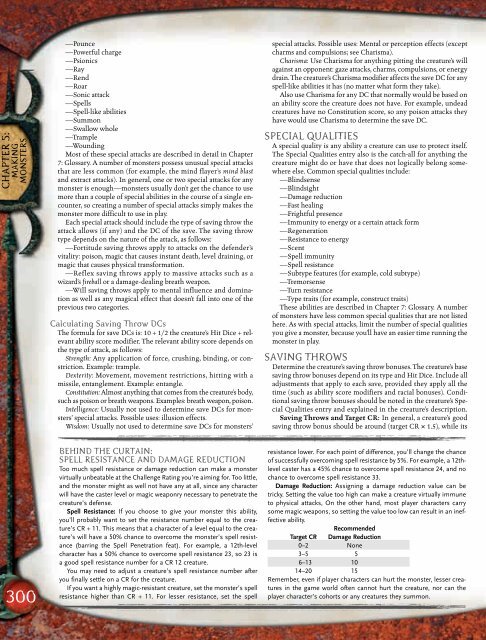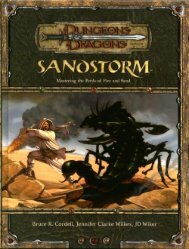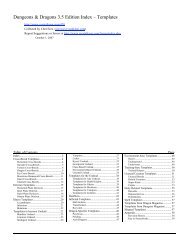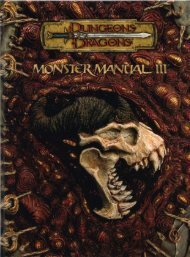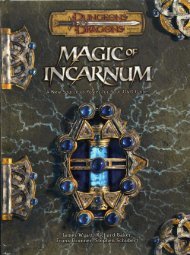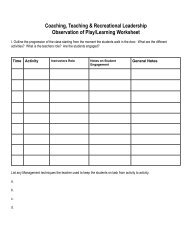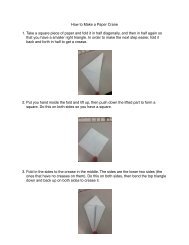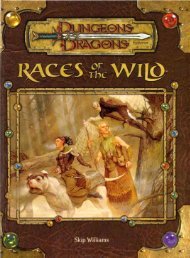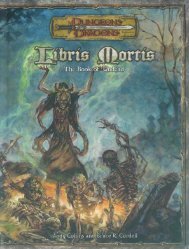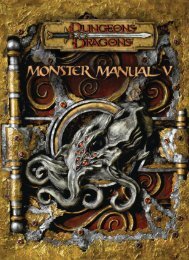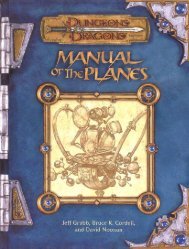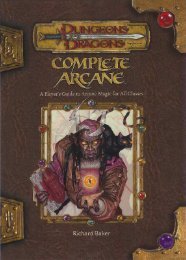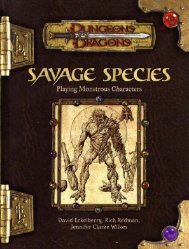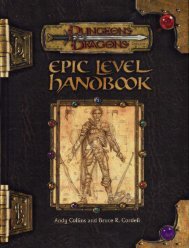Monster Manual
Monster Manual
Monster Manual
- No tags were found...
Create successful ePaper yourself
Turn your PDF publications into a flip-book with our unique Google optimized e-Paper software.
CHAPTER 5:MAKINGMONSTERS300—Pounce—Powerful charge—Psionics—Ray—Rend—Roar—Sonic attack—Spells—Spell-like abilities—Summon—Swallow whole—Trample—WoundingMost of these special attacks are described in detail in Chapter7: Glossary. A number of monsters possess unusual special attacksthat are less common (for example, the mind flayer’s mind blastand extract attacks). In general, one or two special attacks for anymonster is enough—monsters usually don’t get the chance to usemore than a couple of special abilities in the course of a single encounter,so creating a number of special attacks simply makes themonster more difficult to use in play.Each special attack should include the type of saving throw theattack allows (if any) and the DC of the save. The saving throwtype depends on the nature of the attack, as follows:—Fortitude saving throws apply to attacks on the defender’svitality: poison, magic that causes instant death, level draining, ormagic that causes physical transformation.—Reflex saving throws apply to massive attacks such as awizard’s fireball or a damage-dealing breath weapon.—Will saving throws apply to mental influence and dominationas well as any magical effect that doesn’t fall into one of theprevious two categories.Calculating Saving Throw DCsThe formula for save DCs is: 10 + 1/2 the creature’s Hit Dice + relevantability score modifier. The relevant ability score depends onthe type of attack, as follows:Strength: Any application of force, crushing, binding, or constriction.Example: trample.Dexterity: Movement, movement restrictions, hitting with amissile, entanglement. Example: entangle.Constitution: Almost anything that comes from the creature’s body,such as poison or breath weapons. Examples: breath weapon, poison.Intelligence: Usually not used to determine save DCs for monsters’special attacks. Possible uses: illusion effects.Wisdom: Usually not used to determine save DCs for monsters’special attacks. Possible uses: Mental or perception effects (exceptcharms and compulsions; see Charisma).Charisma: Use Charisma for anything pitting the creature’s willagainst an opponent: gaze attacks, charms, compulsions, or energydrain. The creature’s Charisma modifier affects the save DC for anyspell-like abilities it has (no matter what form they take).Also use Charisma for any DC that normally would be based onan ability score the creature does not have. For example, undeadcreatures have no Constitution score, so any poison attacks theyhave would use Charisma to determine the save DC.SPECIAL QUALITIESA special quality is any ability a creature can use to protect itself.The Special Qualities entry also is the catch-all for anything thecreature might do or have that does not logically belong somewhereelse. Common special qualities include:—Blindsense—Blindsight—Damage reduction—Fast healing—Frightful presence—Immunity to energy or a certain attack form—Regeneration—Resistance to energy—Scent—Spell immunity—Spell resistance—Subtype features (for example, cold subtype)—Tremorsense—Turn resistance—Type traits (for example, construct traits)These abilities are described in Chapter 7: Glossary. A numberof monsters have less common special qualities that are not listedhere. As with special attacks, limit the number of special qualitiesyou give a monster, because you’ll have an easier time running themonster in play.SAVING THROWSDetermine the creature’s saving throw bonuses. The creature’s basesaving throw bonuses depend on its type and Hit Dice. Include alladjustments that apply to each save, provided they apply all thetime (such as ability score modifiers and racial bonuses). Conditionalsaving throw bonuses should be noted in the creature’s SpecialQualities entry and explained in the creature’s description.Saving Throws and Target CR: In general, a creature’s goodsaving throw bonus should be around (target CR × 1.5), while itspqqqqrsBEHIND THE CURTAIN:SPELL RESISTANCE AND DAMAGE REDUCTIONToo much spell resistance or damage reduction can make a monstervirtually unbeatable at the Challenge Rating you’re aiming for. Too little,and the monster might as well not have any at all, since any characterwill have the caster level or magic weaponry necessary to penetrate thecreature’s defense.Spell Resistance: If you choose to give your monster this ability,you’ll probably want to set the resistance number equal to the creature’sCR + 11. This means that a character of a level equal to the creature’swill have a 50% chance to overcome the monster’s spell resistance(barring the Spell Penetration feat). For example, a 12th-levelcharacter has a 50% chance to overcome spell resistance 23, so 23 isa good spell resistance number for a CR 12 creature.You may need to adjust a creature’s spell resistance number afteryou finally settle on a CR for the creature.If you want a highly magic-resistant creature, set the monster’s spellresistance higher than CR + 11. For lesser resistance, set the spellresistance lower. For each point of difference, you’ll change the chanceof successfully overcoming spell resistance by 5%. For example, a 12thlevelcaster has a 45% chance to overcome spell resistance 24, and nochance to overcome spell resistance 33.Damage Reduction: Assigning a damage reduction value can betricky. Setting the value too high can make a creature virtually immuneto physical attacks, On the other hand, most player characters carrysome magic weapons, so setting the value too low can result in an ineffectiveability.RecommendedTarget CR Damage Reduction0–2 None3–5 56–13 1014–20 15Remember, even if player characters can hurt the monster, lesser creaturesin the game world often cannot hurt the creature, nor can theplayer character’s cohorts or any creatures they summon.pqqqqrs


